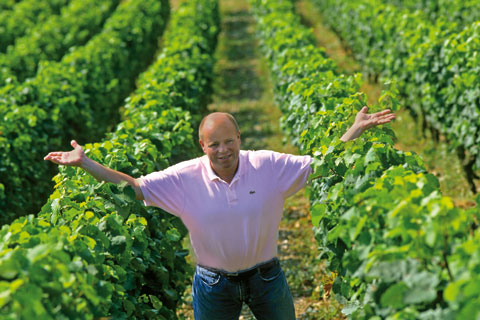Weingut August Kesseler is a winery located in Assamannshausen of the Rheingau region in German. It was established in 1924 by Joseph Kesseler and now has 20 hectares of vineyards planted mostly with Pinot Noir with some Riesling and Sylvaner.
Joseph’s grandson, August Kesseler, is the current owner. He took over the winery from his parents in 1977 when he was still very young. For more than 30 years, he has been constantly thinking outside of the box for ways to improve his wines and is now considered one of the fathers of the red wine revolution in Germany. He has a mission statement for German Pinot Noirs: “To produce grapes from my vineyards that are comparable to the great Pinots from Burgundy but at the same time unique and different from them”. August Kesseler recently shared his thoughts and wine growing philosophy with Asian Palate.
AP – Asian Palate AK – August Kesseler
AP: Growing up in a wine family, did you always know and expect to take over your family business?
AK: I was supposed to work in the car industry but after my parents passed away when I was 19, I made the decision to take over the estate as I had no other choice. Born and raised in Assmannshausen, I used to help my father a lot in the vineyards and the cellar. At the very beginning, I was selling the wines produced in bulk. Then in my second year, I started to go back to malolactic fermentation with my Pinot Noir which was quite unusual at that time. Back in those days, producers preferred to match the acidity with residuals to satisfy the demand for sweet wines. Hence, my wine was unusual to the market. I sold it for 20 Deutsche Marks which was outstandingly high and the profit was enough to finance my studies in winemaking in Geisenheim for the next couple of years.
AP: What are the main changes you feel you contributed to increasing the quality of wines at August Kesseler since you took over in 1977?
AK: I went back to the roots and the practices of the former generations of winegrowers in Assmannshausen – old vines, low yields and a lot of vineyard work. I only produced my Pinot in oak, first 600 and 1,200 liter barrels, then from 1985 until now, in 228-litre Burgundy pieces. In 1988, I became a member of the famous International Pinot Noir Celebration in Oregon and this allowed me to meet other winemakers who taught me a lot about how to handle barrels, such as the type of oak to use or how long to age the wine. This was only the beginning of a strong exchange of experience with winemakers from all over the world which helped me better understand Pinot Noir on an international quality level. One of my main breakthroughs was to sell the first bone dry Pinot Noir from Assmannshausen in 1983 when wines from this region were still sweet.
AP: You make wonderful Rieslings but your Pinot Noirs are also elegant and complex – tell us about your estate’s history with this red variety.
AK: Assmannshausen has a great history in Pinot Noir that is nearly 1,000 years old. Pinot Noir started in the 11th century when monks from France brought over the clones from Clos de Vougeot and planted them in the Rheingau. Then in the 18th century, after discovering the Spätlese and Auslese in Schloss Johannisberg, with its great botrytis, everybody agreed Rieslings are best when they on slopes facing south and on richer soil. But facing southwest, which is a little bit cooler with slate soil as in Assmannshausen, Pinot Noir grows to perfect conditions. From then on, Assmannshausen stood for Pinot Noir only and performed great till today. The effect of global warming, which we have since the 1999 vintage, finally helped a lot to get the fruits riper and to make the style more international and competitive.
AP: What are the key challenges for growing Pinot Noir in Rheingau?
AK: The “key challenge” is finding the passion and the right terroir. You need to grow the grapes on well-drained soil in a vineyard with a climate that gives a warmer, but not hot, temperature with slight breezes to help to dry the fruits quickly after the rain to avoid botrytis.
AP: What do you think is the potential/future of Pinot Noir in Germany?
AK: I am convinced potential can we found in any good places – whether it is in the south or in the north. I personally prefer the north because of the elegance of the terroir that is reflected in the wines. 6. What are the best vintages for Pinot Noir in Rheingau over the past 10 years and is it the same for other parts of Germany for Pinot Noir? I only can speak for Assmannshausen. They were 2012, 2011, 2009, 2007, 2005, 2004, 2003 and the very elegant 2002. The nicest for me was 1999!










